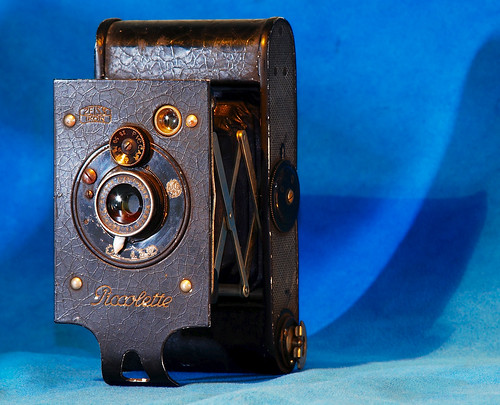Piccolette

|
| Zeiss Ikon Piccolette image by Kimmo Kulovesi (Image rights) |
The Piccolette was first made by Nettel, the company which became Contessa-Nettel, as a folding-bed camera for 4x6.5 cm exposures on rollfilm, from 1914. This camera was available with various lenses, including Nettel's own Anastigmat or Rapid Aplanat, and Pronto or Compound shutter. It has radial lever focusing on the bed.[1]
However, the Piccolette is best-known as a strut-folding camera for eight 4×6.5 cm exposures on 127 film, made from 1919 by Contessa-Nettel in Stuttgart,[2] and continued by Zeiss-Ikon after the merger in 1926 in which Contessa-Nettel joined to form Zeiss Ikon.
It was available with a simple meniscus lens and a simple shutter. Slightly better might have been the one with Piccar f/11 lens and Piccar shutter. A better configuration yet was that with a Novar or Nettar Anastigmat 7.5cm f/6.3 lens and Derval shutter with speeds up to 1/100 sec. A version with faster Tessar lens, Compur shutter, turnable brilliant finder and sports finder was made from 1927 to 1930, the Piccolette Luxus.[3] This has a folding bed in addition to struts, allowing bellows focusing, and perhaps giving a more rigid arrangement of the front standard.
The Piccolette is more or less a copy of the Vest Pocket Kodak, and the camera was copied by Konishroku as the Pearlette.
Notes
- ↑ McKeown, James M. and Joan C. McKeown's Price Guide to Antique and Classic Cameras, 12th Edition, 2005-2006. USA, Centennial Photo Service, 2004. ISBN 0-931838-40-1 (hardcover). ISBN 0-931838-41-X (softcover). p714 (Nettel), 215 (Contessa-Nettel) and 1057 (Zeiss Ikon).
- ↑ Contessa-Nettel Piccolette, with an f/4.5 Tessar and dial-set Compur shutter, at Early Photography.
- ↑ Piccolette de Luxe, with an f/6.4 Doppelanastigmat Citomar and dial-set compur shutter, at Early Photography.
Links
- Piccolette at Pacific Rim Camera
- Piccolette on Collection d'Appareils by Sylvain Halgand